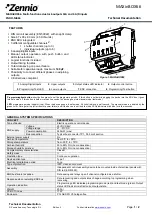
Instruction Manual
D500242X012
A31A Cryogenic-Rotary Valve
February 2019
13
3. Once the seal ring and backup ring have been fully installed into the valve body T‐slot, the retaining ring gasket can
be installed. This gasket is a thin graphite material. Use extreme care to avoid damaging the gasket while punching
one initial screw hole through the gasket for alignment.
4. Install the retaining ring, and align the screw holes in the retaining ring with the holes in the valve body. Install the
first retaining ring screw through the punched hole in the retaining ring gasket. Install the other retaining ring
screws by pushing them through the graphite gasket and threading them into the valve body.
5. Tighten the retaining ring screws just enough to eliminate any movement of the retaining ring. Do not over‐tighten
the retaining ring screws.
WARNING
Avoid personal injury or property damage caused by the impact of a falling or tipping valve. Support large valves during
maintenance.
6. To complete this step, stand the valve up. Support the valve securely using methods appropriate for the valve size.
If a vise or other clamps are being used, make certain the flange gasket sealing area of the valve body is not
damaged.
7. Manually rotate the drive shaft (key 4) to turn the disk clockwise to meet the seal ring.
8. Place a piece of rubber, or other soft material, between the disk and internal travel stop to protect the disk. With a
rubber mallet, tap the disk until it contacts the internal travel stop. When the disk makes contact with the stop,
manually rotate the disk counterclockwise back out of the seal ring to a 90‐degree open position.
10. Repeat steps 8 and 9 two more times.
Note
When attaching the actuator to the valve, make sure the valve disk is not in contact with the internal travel stop. The valve disk
should be positioned from 0.03 to 0.76 mm (0.001 to 0.030 inch) away from the internal stop in the valve body.
CAUTION
When using an actuator, the actuator travel stops or the actuator travel (for actuators without adjustable stops) must be
adjusted so that the disk stop in the valve body does not absorb the output of the actuator. Failure to limit actuator travel
as described in the next step can result in damage to the valve shaft or other valve parts.
11. Use an appropriate tool (such as a feeler gauge) and position the disk from 0.03 to 0.76 mm (0.001 to 0.030 inch)
away from the internal stop in the valve body.
This adjustment is necessary to be certain that the actuator output torque is fully absorbed by the actuator travel
stop or by the actuator. The internal travel stop in the valve body should not absorb any of the actuator torque.
Kel‐F and Kel‐F/Aluminum Seal Installation
Unless otherwise indicated, key numbers and part names are listed in figures 7 and 8.
A maintenance kit with installation tools is available through your














































